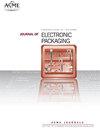Module-Level Thermal Interface Material Degradation in Halt
IF 2.3
4区 工程技术
Q3 ENGINEERING, ELECTRICAL & ELECTRONIC
引用次数: 0
Abstract
In this study, TIM degradation is driven through HALT using temperature cycling with a prescribedvibrational acceleration for two commercially available materials having thermal conductivities of 6.0 and 8.5 W/m-K. HALT specimens were prepared by applying TIM through a 4-mil stencil over AlSiC baseplates in the shape of those used in Wolfspeed CAS325M12HM2 power electronics modules. Baseplates were mounted onto aluminum carrier blocks with embedded thermocouples to characterize the thermal resistance across the baseplate and TIM layer. Thermal dissipation into the top of the baseplates was provided by a custom heating block, which mimics the size and placement of the die junctions in CAS325 modules, applying power loads of 200, 300, and 400W. After initial characterization, samples were transferred to the HALT chamber with one set of samples exposed to temperature cycling only (TCO) and the other temperature cycling and vibration (TCV). Both sample sets were cycled between temperature extremes of -40 and 180 °C with vibrations applied at a peak acceleration of 3.21 Grms. After hundreds of cycles, samples were reevaluated to assess changes in thermal resistance to provide an accelerated measure of TIM degradation. This allows for reliability prediction of useful lifetime (illustrated in a solar inverter case study herein), as well as to provide a basis for developing an accelerated testing method to related temperature cycling to faster methods of degradation. Such techniques provide a means to develop maintenance schedules for power modules for ensuringsufficient thermal performance over the operating lifetime.模块级热界面材料退化停止
在这项研究中,TIM降解是通过HALT驱动的,使用温度循环和规定的振动加速度,用于两种商用材料,其导热系数分别为6.0和8.5 W/m-K。在Wolfspeed CAS325M12HM2电力电子模块中使用的AlSiC基板上,通过4mil的模板涂上TIM制备HALT样品。将基板安装在带有嵌入式热电偶的铝载体块上,以表征基板和TIM层之间的热阻。基板顶部的散热由定制的加热块提供,该加热块模仿CAS325模块中模具结的大小和位置,施加200w, 300 w和400W的功率负载。初步表征后,将样品转移到HALT室,其中一组样品仅暴露于温度循环(TCO),另一组样品暴露于温度循环和振动(TCV)。两组样品在-40和180°C的极端温度之间循环,振动在峰值加速度为3.21 Grms时施加。经过数百次循环后,对样品进行重新评估,以评估热阻的变化,从而提供TIM降解的加速测量。这允许使用寿命的可靠性预测(在这里的太阳能逆变器案例研究中说明),以及为开发加速测试方法提供基础,将温度循环与更快的降解方法相关联。这些技术提供了一种方法来制定电源模块的维护计划,以确保在工作寿命期间有足够的热性能。
本文章由计算机程序翻译,如有差异,请以英文原文为准。
求助全文
约1分钟内获得全文
求助全文
来源期刊

Journal of Electronic Packaging
工程技术-工程:电子与电气
CiteScore
4.90
自引率
6.20%
发文量
44
审稿时长
3 months
期刊介绍:
The Journal of Electronic Packaging publishes papers that use experimental and theoretical (analytical and computer-aided) methods, approaches, and techniques to address and solve various mechanical, materials, and reliability problems encountered in the analysis, design, manufacturing, testing, and operation of electronic and photonics components, devices, and systems.
Scope: Microsystems packaging; Systems integration; Flexible electronics; Materials with nano structures and in general small scale systems.
 求助内容:
求助内容: 应助结果提醒方式:
应助结果提醒方式:


